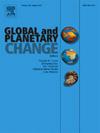Climate and human-induced variability in Holocene Lower Meuse deposition (the Netherlands) identified from the meta-analysis of radiometric data
IF 4
1区 地球科学
Q1 GEOGRAPHY, PHYSICAL
引用次数: 0
Abstract
The meta-analysis of riverine deposition from the Holocene provides critical knowledge on the direction and amplitude of riverine responses to climatic and human perturbations and can help to understand the severity and pacing of future changes. For the Meuse River valley in the Netherlands, a dataset of 340 radiometric dates was compiled, on which a cumulative probability density analysis was carried out to characterize the phasing in clastic and organic deposition throughout the Holocene. The results were compared with established timelines for the geomorphological and cultural changes in the valley and hinterland, and hydroclimatic records in the region and wider North Atlantic climate zone. Wavelet analysis was used to identify persistent periodicities, in an attempt to identify long-term hydroclimatic drivers of the Meuse flooding regime.
The CPDF of clastic deposition reveals limited deposition during the Early Holocene, which we link to the entrenched river setting of that time. Since c. 6 ka BP, the increase in clastic deposition closely followed the trajectory of human impact on land cover. Increased input of clastic material from upland regions led to channel aggradation, which stimulated the formation of floodplain deposits. In the last millennia clastic input increasingly became a limiting factor for the formation of organic deposits, as indicated by their strongly anti-phased correlation.
Increasing human impact during the Late Holocene seems to have created a supercharged setting where particularly during cold climate episodes the flooding regime intensified and sediment fluxes increased. Such hydroclimatic variability manifests as phasing that is superimposed on the general increase in clastic deposition owed to human impact. Although there seems to be a general correspondence between phases of clastic deposition and main drivers of the North Atlantic climate, such as variability in solar activity and the timing of volcanic eruptions, no specific systematic correlations could be established based on CPDF data. Phases of enhanced organics accumulation during the Early Holocene (anti-)correlate significantly with North Atlantic drift-ice occurrence, suggesting a hydroclimatic link between both processes. The presence of multi-centennial-scale periodicities in both organic and clastic deposition during the last four millennia further suggests a persistent climatic driver imprinting on the build-up of the fluvial archive of the Meuse valley.
It is argued that CPDFs are a useful tool to understand hydrological regime changes, particularly to identify phases and episodes of anomalous flooding in relation to the relative importance of climatic and anthropogenic forcings, and the geomorphic modulation of such signals. Such data could be considered as important baseline information for potential future flood regime changes.
从辐射数据的荟萃分析中确定全新世默兹河下游沉积(荷兰)的气候和人为变率
全新世河流沉积的荟萃分析提供了关于河流对气候和人类扰动响应的方向和幅度的关键知识,并有助于了解未来变化的严重程度和速度。对于荷兰默兹河流域,编制了340个辐射测量日期的数据集,并在此基础上进行了累积概率密度分析,以表征整个全新世碎屑和有机沉积的分期。研究结果与山谷和腹地地貌和文化变化的既定时间表,以及该地区和更广泛的北大西洋气候带的水文气候记录进行了比较。小波分析用于确定持续的周期性,试图确定默兹河洪水制度的长期水文气候驱动因素。碎屑沉积的CPDF显示了早全新世时期的有限沉积,这与当时根深蒂固的河流环境有关。自c. 6 ka BP以来,碎屑沉积的增加与人类对土地覆盖的影响轨迹密切相关。来自高地地区的碎屑物质输入增加,导致河道淤积,刺激了洪泛平原沉积物的形成。在过去的一千年中,碎屑输入日益成为有机矿床形成的限制因素,这表明它们具有强烈的反相相关性。在晚全新世期间,人类的影响日益增加,似乎创造了一个增压环境,特别是在寒冷气候时期,洪水加剧,沉积物通量增加。这种水文气候变率表现为相位,叠加在由于人类影响而导致的碎屑沉积的普遍增加上。尽管碎屑沉积阶段与北大西洋气候的主要驱动因素(如太阳活动的变率和火山喷发的时间)之间似乎存在普遍的对应关系,但基于CPDF数据无法建立具体的系统相关性。全新世早期有机物积累增强的阶段(反)与北大西洋漂冰的发生显著相关,表明两者之间存在水文气候联系。在过去的四千年里,有机沉积和碎屑沉积中出现了百年尺度的周期性,这进一步表明,在默兹河谷河流档案的形成过程中,存在着持续的气候驱动因素。cpdf是了解水文状态变化的有用工具,特别是识别与气候和人为强迫的相对重要性有关的异常洪水的阶段和事件,以及这些信号的地貌调节。这些数据可以被认为是未来潜在洪水形势变化的重要基线信息。
本文章由计算机程序翻译,如有差异,请以英文原文为准。
求助全文
约1分钟内获得全文
求助全文
来源期刊

Global and Planetary Change
地学天文-地球科学综合
CiteScore
7.40
自引率
10.30%
发文量
226
审稿时长
63 days
期刊介绍:
The objective of the journal Global and Planetary Change is to provide a multi-disciplinary overview of the processes taking place in the Earth System and involved in planetary change over time. The journal focuses on records of the past and current state of the earth system, and future scenarios , and their link to global environmental change. Regional or process-oriented studies are welcome if they discuss global implications. Topics include, but are not limited to, changes in the dynamics and composition of the atmosphere, oceans and cryosphere, as well as climate change, sea level variation, observations/modelling of Earth processes from deep to (near-)surface and their coupling, global ecology, biogeography and the resilience/thresholds in ecosystems.
Key criteria for the consideration of manuscripts are (a) the relevance for the global scientific community and/or (b) the wider implications for global scale problems, preferably combined with (c) having a significance beyond a single discipline. A clear focus on key processes associated with planetary scale change is strongly encouraged.
Manuscripts can be submitted as either research contributions or as a review article. Every effort should be made towards the presentation of research outcomes in an understandable way for a broad readership.
 求助内容:
求助内容: 应助结果提醒方式:
应助结果提醒方式:


